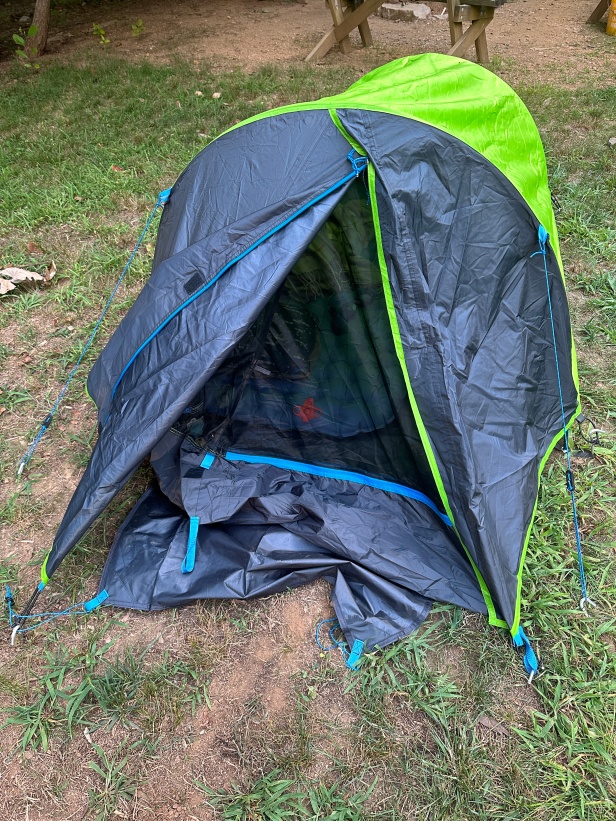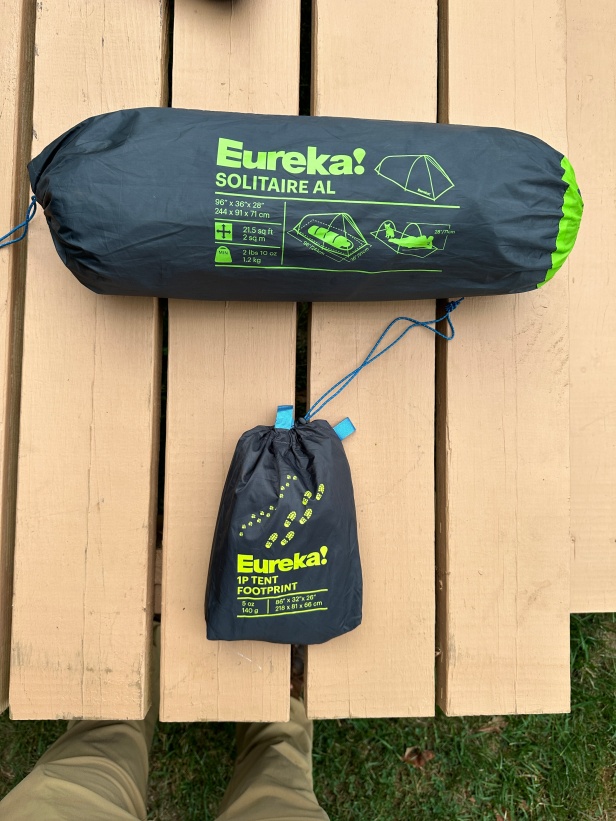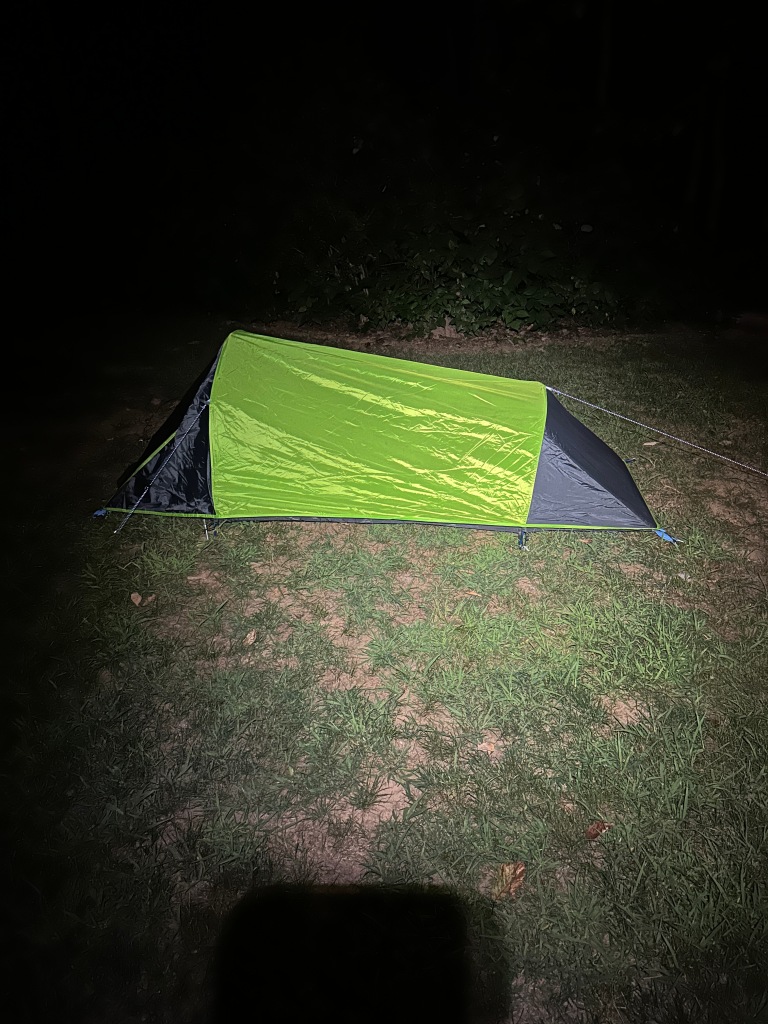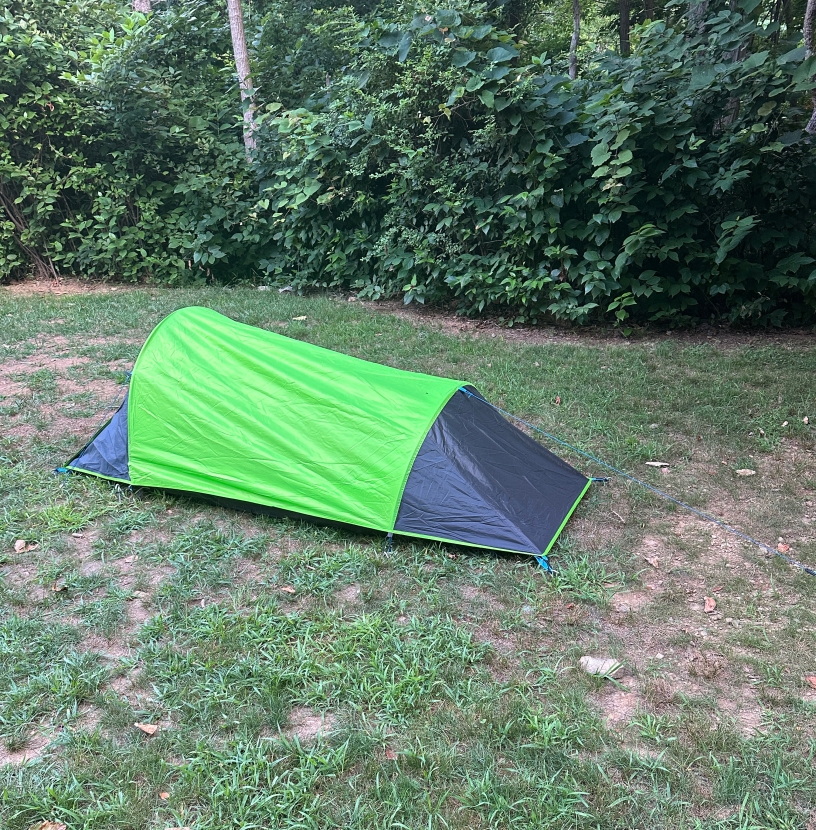Note: Many of our articles, including this one, feature affiliate links. If you end up buying a product using our links, we get a small kick back from the company at no cost to you. So if you enjoyed this article and would like to help us out, please be sure to use our link!
Whoa, this article has been a long time coming. I teased this nearly half a year ago and just never got around to taking pictures of the tent. To be honest, the first time I used this tent, we were having so much fun I did not even think to take a picture. But that’s good news for you because I’ve now used this tent again for a summer camping trip and can offer additional perspectives! Jason and I have now completed two short backpacking trips with some friends on a 35 mile section of the Appalachian Trail. We have tons of gear that we used on these trips and have been planning out how to review it all. For the tents in particular, we did a fun experiment. We traded tents on the second night of our first trip (a mild fall trip) so that we could each give some insight into what we liked best about the two tents. On our latest trip (a hot, but not scorching, summer trip), I cozied up again in one of the tents, the Eureka! Solitaire AP one person tent.
In this article, I’m going to put in my 2 cents for the Eureka! Solitaire AL 1 Person tent. This is consistently touted as a contender for a great budget one person tent, and I’ll get into why I tend to agree with that sentiment.
The Design:
This is a “coffin” style tent. Having never used this style before, I didn’t know what to expect. I actually really like the design and would probably opt for this style again. In true dad fashion, I proclaimed this tent my “Chris-alis” and emerged the next day a beautiful butterfly.


Feature-wise, this tent is fairly straightforward. I was actually surprised that it had multiple entry options: either shimmy through the the head side flap or go in through the top. Granted the rain cover will need to be removed to go in through the top ridge zipper. For those interested in technical specs, the floor space of the tent is 96” x 32” and the maximum height by your head is 28”. This gives you a footprint of about 21.5 square feet. While not a heavy tent, this is by no means lightweight either, coming in at nearly 3 pounds, 4 ounces. It does pack up nice and small, so it can easily fit inside your pack or strapped to the outside.

Ease of Setup:

I got this tent on the first night of our Fall trip and went about setting it up after hiking 13 miles. It was getting dark by the time we got to work, so that added some additional complexity. Nothing my headlamp couldn’t help with though. The tent conveniently comes with a footprint to protect the bottom of the tent, which is good since our home for the night had gravel campsites. Much like many other tents, the instructions were printed on the inside of the carrying case. Setup was a breeze despite being exhausted. The two poles are slightly different lengths, the longer one for the head and the shorter one for the foot of the tent. They will not support the tent by themselves though, so once the poles are in, you have to start staking the corners to make the tent keep its shape. At that point all that is left to do is to put on the rain cover and stake down the guy lines. The nice part is that the rain cover is already attached to the top of the tent body, so it makes setup even easier. I’d say overall the tent was pretty easy to put together for my first time and even easier the next time I set it up.
Comfort:
I had an excellent night sleep in this during our fall trip and did not feel cramped at all. For reference, I’m 5’8” and I had more than enough room to spread out and even stash my pack inside of the tent by my head rather than in the small vestibule outside. You could stash your bag to the side, but if it rains, you might regret it! Obviously you cannot stand up inside this tent, but there was more than enough room to sit up to change clothes and move things around the tent. I also felt like I had plenty of room on either side of me which gave me more freedom to spread out. Definitely a very cozy tent! I will say (and this is my fault), it got quite toasty during our summer trip. It cooled off as the night went on, but I had the rain cover deployed just in case a summer storm rolled through. I would have been better off pulling back the rain cover and not only enjoy the cooler air, but also the nice view through the mesh ceiling.
Durability:
It’s a little too soon to talk durability, but I will highlight that the stakes are very lightweight. Not a problem if you’re staking into soft soil, but some of the stakes started deforming when trying to hammer into packed gravel campsites. Probably worthwhile to pick up some spares.
Pros:
- Surprisingly roomy inside
- Easy to set up even on your first try
- Packs up small for transport
Cons:
- Very lightweight and cheap stakes
Rating: 5/5
Other than the unknown durability factor, I’d say that the Eureka! Solitaire AP 1P (one person) tent is nearly a perfect option for a single person tent. Simple construction and a surprising amount of space makes this a great option for your next camping trip!
Have you had the Eureka! Solitaire AL 1P tent for longer and can attest to its durability? Let us know in the comment section below!


I have been looking at some of you guys’ posts; I am a gearhead in more ways than just my thing for cars, so I have enjoyed reading. I really like Eureka tents. I have no personal experience with the Solitaire (our Scoutmaster has one), but I have a Midori 1, which I found to suit me very well (nice vestibule, side entry, and enough room for me to sit up and make my coffee in the morning). My son and I also have a Midori 3 for when we’re splitting a tent between our packs, and we like that one, too. This is probably way overkill, but I replaced the cheap aluminum stakes with MSR Mini Groundhogs, which I am finding to have excellent hold for their small size. I also made a footprint for the Mid 1 (it doesn’t come with one) by slitting one of my large trash compactor bags so I could splay it open lengthwise; almost a perfect fit! The Mid 1 scores high in the durability and livability factor, but definitely comes in a bit heavy at over 3.5 pounds (the Mid 3 is more like 6.5; more with the fitted footprint). Anyhow great review on the Solitaire. I am reading that Johnson Outdoors is no longer going to be making Eureka tents; I really hope someone picks up the product line and continues the legacy. So many great products.
LikeLike
Ah, that’s a shame. Jason turned me onto this tent since it was well recommended as a budget single person tent. I tested his out and bought one of my own! If it does get discontinued, it would make a great pickup at a sale price!
LikeLiked by 1 person
I agree. I am still crossing my fingers that someone else picks up Eureka and moves forward with their legacy. It is a very strong brand IMO. I borrowed a Eureka Sunriver 3 (the somewhat cheaper, slightly de-contented Dick’s Sporting Goods version of the Midori) for the first backpacking trip my son and I took together, and the design, construction and obvious quality were a revelation at that price point compared to what I was used to.
LikeLike